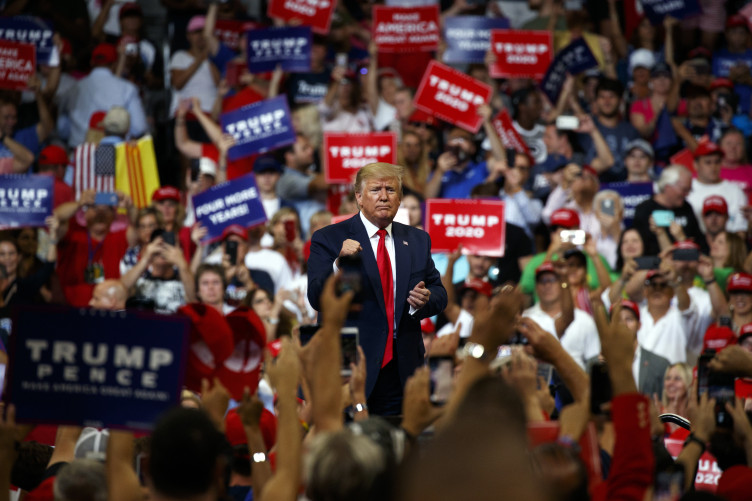
ALMOST exactly four years after his infamous speech announcing his bid for the White House, President Donald Trump on Tuesday, June 18 officially launched his 2020 presidential reelection campaign in a rally with his supporters in Orlando, Florida.
When he walked on stage and officially kicked off his campaign, Trump — who unofficially sloganed his 2020 campaign “Keep America Great” — promised his supporters a continuance of his administration’s effort to make America great again.
“With every ounce of heart and might and sweat and soul, we’re going to keep making America great again and then we will indeed keep America great,” Trump told his supporters. “And that is why tonight, I stand before you to officially launch my campaign for a second term as President of the United States.”
The overall message of the campaign kickoff offered nothing new and, minus the official announcement, moved along like his usual rallies.
Trump reminded supporters of his stringent plans for immigration in the name of national security, saying, “We believe our country should be a sanctuary for law-abiding citizens, not for criminal aliens.”
And in true Trump fashion, he peppered in his favorite digs at “fake news,” Hillary Clinton (he promised supporters to find her emails “somewhere deep in the State Department”) and the Democrats, claiming that the party is “driven by hatred, prejudice and rage” and “want to destroy our country as we know it,” positioning himself as a salve for that perceived threat.
With the assistance of a lineup of speakers, the showy campaign rally featured speeches from the president’s family and Vice President Mike Pence who keyed into the sentiment with classic conservative rejoinders of “taking America back.”
“Jobs are back, confidence is back and thanks to the leadership of President Donald Trump, America is back, and we’re just getting started,” Pence said to a raucous sea of red “Make America Great Again” hats and signs.
Though Trump’s re-election campaign is not surprising in any way (only four incumbent presidents in U.S. history have opted not to run for a second term), he officially enters the race with a booming economy under his wing but low approval ratings. (A recent Fox News poll put him 10 and 9 percentage points behind Joe Biden and Bernie Sanders, respectively.)
But history shows that economic standing and the job market have massive influences on reelection chances.
Last month, the national unemployment rate dropped to 3.6% which is the lowest unemployment rate since 1969, according to the Bureau of Labor Statistics. Though national issues such as immigration, health care and identity politics like race and gender are often used as an arsenal against the president, the RNC highlighted the president’s first term as “a series of promises made and promises kept.”
“From delivering a once-in-a-generation tax cut to cutting regulations, reducing the price of prescription drugs and nominating two Supreme Court Justices, our economy is roaring and President Trump is delivering for all Americans,” a spokesperson for the RNC said.
The Democratic counter
After Trump’s rally, the Democratic National Committee (DNC) hosted a counter-rally in Florida this week that focused on the “outlandish promises” Trump made while running in 2016 regarding health care and immigration that left a lot more to be desired, according to John Santos, AAPI media director for the DNC.
When asked how the Democratic Party should move forward as the debate stage of the election approaches, Santos said that focusing on issues and providing solutions to the “pitfalls” of Trump’s first term should be top of mind for the 20-plus Democratic candidates currently in the running.
“Our entire campaign should not just be about how are we going to oppose Trump, and it should be about issues at hand, like how are we going to ensure there’s greater access to health care and how are we going to get rid of the inhumane immigration procedures at the border and establish a more effective immigration system in general, and I think that’s what the party needs to focus on,” Santos said.
But Santos added that it’s also important that the public be reminded of the “failed promises” and the proposals he made during his first term that “actually damaged many Americans” like his proposed termination of the Deferred Action for Childhood Arrivals (DACA) program and the effort to kill the Affordable Care Act (ACA), the latter of which has lowered the uninsured rate.
Before the ACA, 48.6 million Americans were uninsured and after the ACA, that number lowered to about 28 million, according to data from the Centers for Disease Control and Prevention.
After the 2016 election, the Democratic Party fell into a period of reflection and examining how best to move forward and agree on a cohesive focus, and Santos acknowledged the diversity of views within the Democratic Party, such as the disparate views on the Medicare For All campaign and reinstating the ACA.
Despite the perceived party-wide disarray characterized by cable news pundits, Santos believes that the collective goal of unity, inclusion and racial and gender equity of the party at large aligns with the direction of the country and the culture.
“It’s fine to have those disagreements, but as long as everyone in the party believes in making sure that everyone has access to affordable health care and as long as we understand that that’s the common goal, I think we are starting from a really strong standpoint,” Santos said, noting that the Democratic Party represents “the future of America.”






